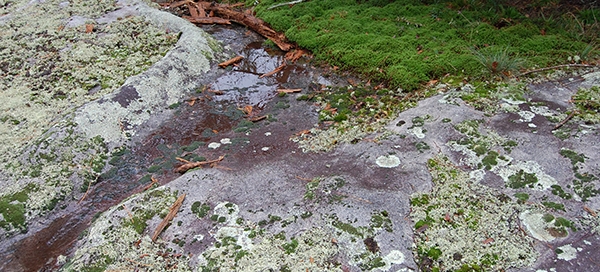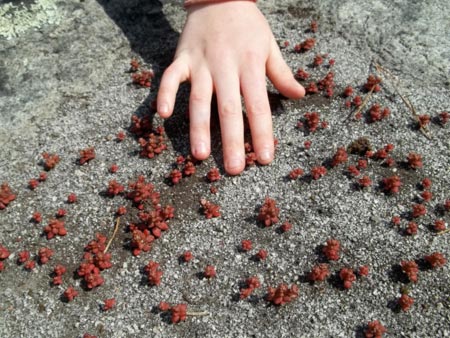Triangle Land Conservancy’s Temple Flat Rock Preserve was recently named one of WakeWonder’s Seven Wonders of Wake County by the WakeNature Partnership. On Saturday, November 7, join Leigh Ann Hammerbacher, TLC’s Associate Director of Conservation and Stewardship, for a special tour of Temple Flat Rock Preserve. The tour of will begin at 10am, followed by an optional service project.

Temple Flat Rock Preserve, one of the Seven Wonders of Wake County as identified by the WakeNature partnership
Temple Flat Rock Preserve was Triangle Land Conservancy’s first conservation project in 1984. According to Leigh Ann, Temple Flat Rock is a very special location because of a unique undisturbed granitic outcrop located on the property, which has over 40 species of lichens and flowering plants growing on it. The exposed outcrop is part of the Rolesville Granite Botholith, which lies beneath the ground throughout the eastern Triangle region.
Temple Flat Rock is a registered Natural Heritage Site under the State’s Natural Heritage Program because of its unique and diverse biological community. Under this designation, Triangle Land Conservancy and the Natural Heritage Program work together to protect this special natural area.

Temple Flat Rock supports a unique and diverse biological community.
In total, Temple Flat Rock Preserve is 32 acres, including 5 acres of mature oak-hickory forest and 13 acres of loblolly pine forest. TLC performs restoration activities at Temple Flat Rock such as removing invasive species, prescribed burns, and converting an old agricultural field into a native Piedmont meadow. When asked about the importance of invasive species removal and conducting prescribed burns, Leigh Ann said,
“Both the outcrops and meadow are in danger of being taken over by invasive and early successional species. One of the reasons the flatrock habitat is so rare is that most of the communities in the piedmont have not been managed and have been subsequently out-competed by woody vegetation and invasive species. In the past, these areas would have naturally stayed open through wildfires. Both flatrock areas and piedmont meadows have become extremely rare in this region and many native plants and wildlife species have suffered. The open habitat of this 17-acre piedmont meadow establishment supports a variety of warm season native grasses, forbs and associated species increasing the area’s biodiversity. Many endemic [only found in North Carolina] native animals and migratory bird species utilize these critical habitats. [By doing these restoration activities], it will demonstrate ecological conditions as they were prior to the arrival of European settlers. Over 149 species of butterflies have been documented on the preserve as well as 44 species of lichen.”
Raleigh Charter High School has partnered with TLC for many years and its students have the opportunity to help restore the preserve through service learning projects.
With ongoing restoration activities and high sensitivity to disturbance, Temple Flat Rock Preserve is closed to the public. While groups like the Center for Human-Earth Restoration, researchers, and students visit often, tours for the community are rare. According to Leigh Ann, the goal is to preserve the site for future generations to learn about this unique natural area.
When asked about the November 7th tour, she said that visitors will have the opportunity to walk on the flatrocks to learn about the unique features and community of species located in Temple Flat Rock Preserve. Visitors will also see the rest of the property and learn about the conservation and reestablishment of native species, and hopefully, have the chance to see birds, butterflies, and other animals.

Help create Monarch butterfly habitat after the hike by planting milkweed in the Temple Flat Rock meadow.
Visitors are welcome to participate in a service project to plant milkweed, an important plant that supports Monarch butterflies, after the hike. It will be a great opportunity to help protect the North American Monarch butterfly, as many threats such as habitat loss could cause the species to become extinct within our lifetime. Monarchs use milkweed as habitat to lay their eggs and as food for their caterpillars to eat. The open meadow at Temple Flat Rock will hopefully support the species well into the future along with a growing number of other Monarch waystations created in this region.
If you would like to join TLC and Leigh Ann on November 7, please sign up here.
